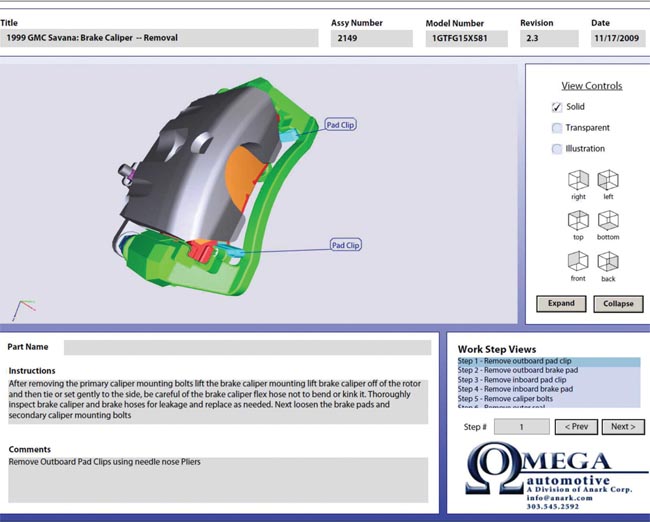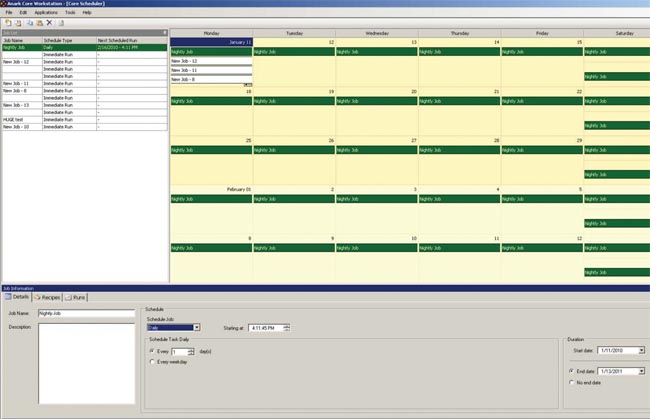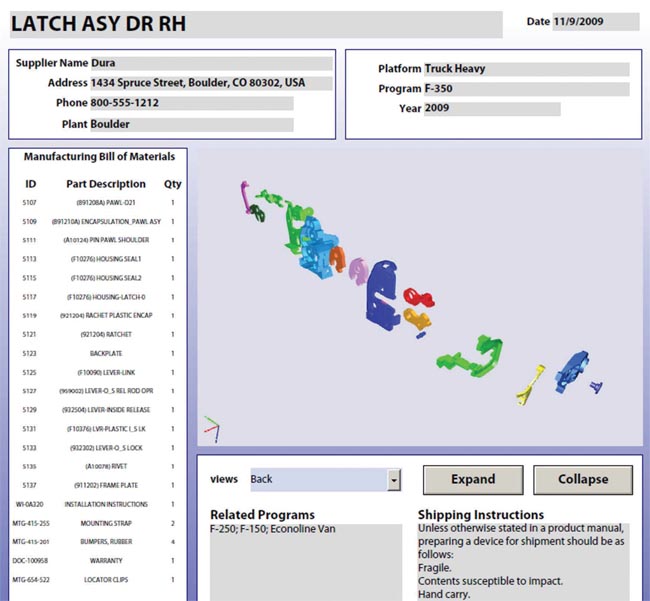Anark Core 3.0 Now Does More than Ever
3D PDFs, product data integration, and new annotation capabilities are just some of the new capabilities offered by the latest version of this collaboration program.
Latest News
April 1, 2010
By Mike Hudspeth
Demands on your time and attention can be enormous. At work, your boss wants you to do stuff. Your coworkers want you to do stuff. Your customers want you to do stuff. At home, your significant other wants you to do stuff. And if you’ve got ‘em, your kids want you to do stuff. And you want to do your own stuff. The two things all these have in common is that 1) it’s you that does the stuff and 2) all the stuff you have to do is different depending on who wants it done. Your engineering data has it just as bad.
 Figure 1: Your customers need to know how to work your products. You can set up your data to show them how to do anything. |
Anark Core 3 administers those demands. And that’s good news because your engineering data is solid gold to your company. If it wasn’t they wouldn’t need you. Anark Core lets you share your data with everyone in your company (and outside of your company) while protecting the important stuff.
The Work Flow
Your data tells everything there is to know about your products. It has to be kept under wraps, but has to be let out to be useful and go to work for you. Anark Core 3 lets you grant access to your data to people outside your sphere of influence who might not understand your data, but can use parts of it without ruining it.
Anark Core has always protected your engineering data, but the latest version makes it easier for you to present it via tighter integration with your software. It enables you to control who gets what so collaboration is simplified and streamlined. Most companies have technical illustrators that work hard to build the manuals your customers are going to need (see Figure 1). These guys (and gals) don’t need all the detail you’ve put into the model, so Anark Core 3 will give them just what they need by enabling your illustrators to edit the data and simplify it. The same goes for the sales department that needs to put your data into a form like a catalog page the customer can access to make a buying decision; procurement who needs your data to order materials for production; packaging who needs it to design a container for the product; and so on. Anark Core 3 can give it to them all—and then some.
Information In
Anark Core 3 can also pull data in from just about any source. Special licensing agreements with numerous software vendors allow data to be imported. It enables great versatility in how you can use data that you didn’t create. It grants access to data found on many vendor websites to import models and material attributes. This means you don’t have to model all of your resistors, transformers, capacitors, LEDs, chips, etc. You can link to the manufacturer’s website or even import data from your PDM system. The really nice part is that this is live data linked back to all systems. That means if something changes in the original system, it will update in Anark Core 3.
 Figure 2: Anark Core 3 has a great extra add-on called Scheduler. With it, you can rebuild and/or update all your files when there’s no one in the office. Of course, that will eliminate your need for one coffee break. |
Changes and Recipes
As mentioned earlier, all sorts of people need to access your data but they don’t need all of it. They just need what they can use. So when the data is imported into Anark Core 3 you can change it to meet your needs. You can eliminate what you don’t need and change what you do. You can mix different data sources and come up with something new. You’re not linked to just CAD data anymore, you get everything. You can import attribute data from multiple sources. You can click and display attributes (some of which you can change), all without changing the original data. That way it’s safe. Anything you do with the data, any changes you make, gets stored in a “recipe.” These recipes are lists of instructions that Anark Core 3 uses to recreate data the next time it’s opened. You can build recipes that reference data from PDM, MES, and other systems. When changes are made, you run the recipe and everything updates.
Information Out
Anark Core 3 is particularly useful for design reviews. You can mark up your data for later changes. You can import work instructions from your MES system. When you display your data, you don’t have to use the original colors from models. (I had an engineer friend once who insisted on using all kinds of colors in his models. His eyes weren’t what they used to be so he wanted the highest visibility he could get. Consequently, his models fairly glowed with unnatural combinations.) In Anark Core 3 you can change all that and make things the way you want them.
Of course, once you’ve made all the changes you want and have added in the information you need, you can then export it in many different formats so it can work for you.
 Figure 3: When you make your catalog pages you can even build in the capability to explode your assemblies. |
When you buy Anark Core 3, you get a full license of Adobe Acrobat Pro Extended. A strategic alliance with Adobe means you can create all kinds of PDF documents—especially 3D PDFs. If you’ve not looked at Acrobat Pro Extended lately you’ll likely be amazed at what you can do with it.
The Acrobat license means you can attach annotations to faces, then export them with views to a PDF. You can export PDFs of each component in your assembly, if you want. You can put actual B-rep data in your PDFs. That means you can rotate and zoom in 3D. You can even explode your assembly in the PDF (see Figure 3). That’s great for online work instructions and manuals. It also makes for a good support tool (think call center support). No one need guess anymore at how things go together. It’s also good on the manufacturing shop floor. No more fumbling for dirty, out of date drawings. You can include data dimensions so technicians can measure and record the actual product and compare it to the intended values. Queries can access data configurations just like in SolidWorks (e.g., common components are found in two-door vs. four-door cars). So it’s no problem if one model of your product has four LEDs on its PCB and another model has only two. Just access the right configuration. It’s that easy. All that makes your PDFs a good quoting tool (design engineer meets procurement). And don’t worry about the security of your data. Digital Rights Management protection comes from Adobe. You can tether privilege control back to you and revoke it at will.
You also have access to Adobe Life Cycle Designer, which means you can design PDF templates, mapping the fields to the data. And lastly, you can add Scheduler (see Figure 2). This is an Outlook-like program that you can set to keep things up to date. It will wait patiently until the time of your choosing, then go out and access every link in your Anark Core 3 file and check to see if anything has changed. If so, Scheduler will activate an update.
The Core ROI
Anark Core 3 does plenty, but it’s not cheap, ranging from $4,500 to $10,000 (for the individual Workstation license and support docs), including the bells and whistles you choose, to $5,400 to $10,000 (for the Server license), which includes automation and Scheduler. But if it lets you do your job in half the time, it’s like having another full-time employee helping you. I’d say that’s a bargain.
More Info:
Anark Corp.
Mike Hudspeth, IDSA, is an industrial designer, illustrator, and author who has been using a wide range of CAD and design products for more than 20 years. He is DE’s expert in ID, design, rapid prototyping, and surfacing and solid modeling. Send him an e-mail about this article to [email protected].
Subscribe to our FREE magazine, FREE email newsletters or both!
Latest News






